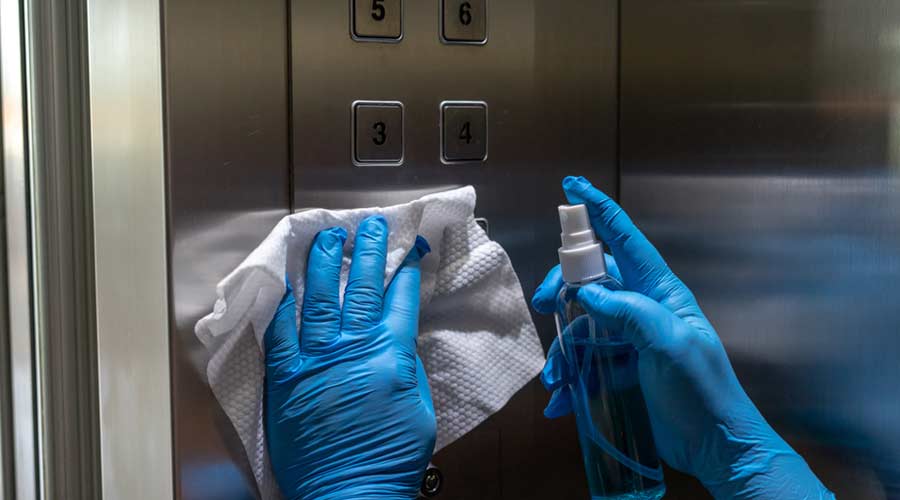
High dusting may require different tools than what teams already have in their arsenal. Various manufacturers sell high dusting kits made from lightweight carbon fiber tubes that can be configured to reach from 10 feet up to 50 feet, says Carrizales.
“Many of these manufacturers also have a camera accessory that goes on the end of the wand to give the operator a birds eye view of what is being cleaned,” he adds.
Desktop dust meters or particle counters can also be valuable resources for departments. They can measure and graph airborne dust levels, which helps take the pulse of a dusting program, its methods, and outcomes.
“Such monitoring enables better dust-source detection, prevention and capture; reducing labor by thousands of dollars annually,” explains Rathey.
One of the more valuable tools departments can use to tackle high dusting is a vacuum. Whether or not that vacuum needs to be corded or battery powered is debated by experts. Carrizales explains that corded vacuums generally have stronger suction, can run indefinitely and are usually the expensive choice. Battery-powered models work well in stairwells, elevators, and for quick cleanups where cords may create a safety hazard. But they are also heavier and may contribute to operator fatigue.
Meanwhile, Selkow prefers specific vacuums that are rated for anti-static and spark safe (explosion proof). They are more expensive than regular vacuums and only come in the corded models.
Finally, Rathey doesn’t take a stand on corded or battery, but emphasizes the use of backpack vacuums because they enable more access to some areas. He adds that filtration can be exceptionally good with backpacks as their suction-only operation drives more airflow and suction.
When it comes to filtration, many managers wonder whether HEPA filters are necessary for the vacuums used for high dusting. Carrizales favors HEPA filters based on the larger amount of dust being collected versus the smaller amount gathered during daily vacuuming.
“HEPA filters particles down to 0.3 microns,” he says. “With the higher dust load on elevated surfaces, there are more allergens like pollen mold spores, dust mites, and possible pet dander, if it is a pet-friendly environment.”
The Centers for Disease Control and Prevention (CDC) recommends HEPA systems to improve air cleaning — especially in higher risk areas like hospitals or doctors’ offices, or places where people may have a higher likelihood of having a respiratory disease or contracting one.
So, after making a decision on the best vacuum for the job, how does one reach those high areas? Whitzell recommends lifts and ladders.
“Architects design buildings without any thought to building cleaning and maintenance when the facility goes into use,” he says. “For example, using a scissor lift on a limestone floor might crack it, but you need that lift if the room has a high atrium.”
High dusting is higher risk cleaning because of the room design and also because it requires lifts and ladders, explains Selkow. This task calls for two people to complete — one doing the work and the other acting as a spotter.
In areas where cleaning teams can ditch ladders and lifts, use lightweight extension poles with the right attachments, he says. Telescoping poles with flexible hoses and angled tools help workers reach vents, pipes and ledges without dragging out a ladder. This is both safer and more efficient. Also, look for brush or crevice attachments that can flex around corners and odd-shaped surfaces. Soft bristles on the brushes work well for smooth surfaces and harder bristles perform better on rougher surfaces.
Selkow emphasizes that different buildings have different structures (pipes, ledges, etc.) and cleaners need the correct dust-collecting tools to get the job done.
Any head will have bristles to help loosen dust from both level and non-level surfaces, explains Carrizales.
“Depending on the surface being cleaned, the head may be small and round or a straight head that comes in various widths,” he says. “Some are flexible, and I have even seen some that are curved for various sized round ductwork.”
Rathey says the need for high dusting is a touchstone for IAQ because the presence of settled dust is an opportunity to understand the sources and allergens present. Even knowing the causes, dust is here to stay. Managing dust for better health and facility cleanliness is essential in a world where the indoor space is the one environment where cleaning teams have control.
Heather Larson is a freelancer based in Tacoma, Washington.
AI Applications for High Dusting
Technology is driving innovation throughout the industry and high dusting is no exception. Some departments could benefit from the use of AI in this area, say experts. In fact, Allen Rathey, director of the Indoor Health Council, has noted momentum in cleaning teams asking AI assistants for insights on how to protect dust-related IAQ in specific facility types.
One option is localized IAQ monitors linked to localized air purifiers. This is an AI-driven tool that activates the air-cleaning process when certain pollutants or particle levels are detected, but it can get quite expensive. Robotic floor cleaning machines with good filtration can also reduce some of the particles that become airborne.
Meanwhile, Phil Carrizales, director of hygiene and facility solutions at Acme Paper and Supply Company, isn’t aware of any AI applications currently available for high dusting, but he’s heard about some companies using small drones with a camera attached to evaluate high, hard-to-access areas for potential dusting. Depending on the operator’s skill level, this could cause copious amounts of dust to become airborne.
At the rate that technology is evolving, experts predict that new tools and techniques will aid in simplifying these high-dusting tasks.
Multi-use Tools Boost Cleanliness in Hard-to-Reach Corners

 Celebrating BSCAI's 60th Anniversary eBook
Celebrating BSCAI's 60th Anniversary eBook The Down and Dirty on Cleaning in Virus Season
The Down and Dirty on Cleaning in Virus Season How Surfactant Use is Expanding in Commercial Cleaning
How Surfactant Use is Expanding in Commercial Cleaning